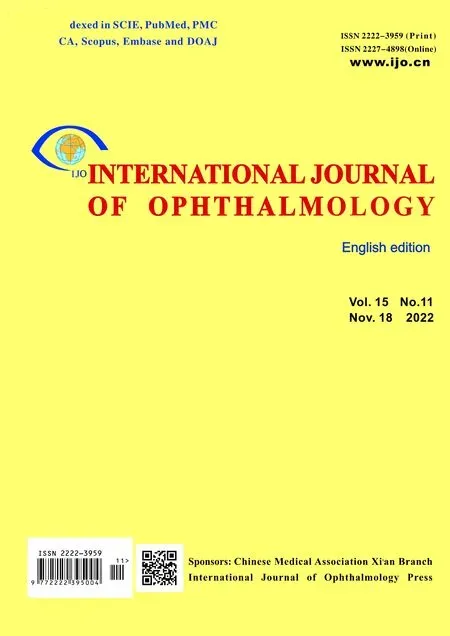Comment on: Long-term hemodialysis improved and stabilized diabetic macular edema: two case reports
Yusuke Kameda, Yuta Suzuki, Megumi Sugai, Karin Ishinabe, Nichika Fukuoka
Yotsuya-sanchome Ekimae Eye Clinic, Tokyo 160-0004, Japan
Dear Editor,
With great excitement, we read the article titled “Longterm hemodialysis improved and stabilized diabetic macular edema: two case reports” by Fan and Yuan[1]; a case series study which provided interesting novel insights into the beneficial effect of hemodialysis (HD) on diabetic macular edema (DME). Although we congratulate the authors for a valuable case presentation, we feel that their study did not mention the mechanism by which it suppresses the pathogenesis of DME. Therefore, we would like to provide supplementary comments through many years of our research regarding the association between diabetic eye disease and HD.
In general, patients with end-stage diabetic kidney disease who crucially need HD are likely to have fluid overload[2].Under the condition of fluid overload, an imbalance between the colloid osmotic and the hydrostatic pressures favors fluid movement from the vascular to the extravascular compartment, as stated in Starling’s principle[3]. Thus, patients with fluid overload and microvasculopathy due to the longterm effects of diabetes might readily suffer from exacerbation of DME, possibly resulting from the increased retinal vascular permeability[4]. However, the initiation of HD, such as in the study by Fan and Yuan[1], ameliorated the conditions associated with fluid overload, resulting in the resolution of DME. Takamuraet al’s[5]multicenter study including 132 eyes during the 12-month period after HD initiation reported that the anatomical and functional outcomes of DME significantly improved immediately after initiation and were maintained until the end of the study period. Hence, HD as a treatment for fluid retension is an important therapeutic option for patients with DME and fluid overload due to end-stage diabetic kidney disease. Incidentally, this mechanism can be applied to other medical treatments. Kamedaet al[4]and Ciardella[6]reported cases, with fluid overload and extensive DME, who experienced marked improvement in DME after only strict medical treatment including administration of furosemide.
In contrast, many ophthalmologists are concerned that starting HD in patients with advanced stage of diabetic retinopathy could have a higher risk of subsequent vitreous hemorrhage(VH), as HD requires systemic anticoagulation with unfractionated heparin. However, somewhat surprisingly, HD might suppress the pathogenesis of VH, as well as DME. In our previous study, including 145 eyes during the 12-month period before and after HD initiation, the incidence of VH was significantly lower in the HD stage than in the pre-HD stage[7].Moreover, our recent study reported that HD has a benefical impact on vitrectomy outcomes; the 6-month incidence of VH and neovascular glaucoma following vitrectomy for proliferative diabetic retinopathy was significantly lower in the HD group than in the stages 3-5 chronic kidney disease group(in patients not on HD)[8]. Based on these reports, we believe that HD may play a significant role as a “game-changer” in various situation of diabetic eye disease, and the cases of Fan and Yuan’s[1]study confirmed our hypothesis.
ACKNOWLEDGEMENTS
Authors’ contributions:Kameda Y researched the data,wrote the manuscript, and contributed to the discussion.Suzuki Y, Sugai M, Ishinabe K and Fukuoka N contributed to the discussion, and reviewed and edited the manuscript. As the corresponding author and guarantor of this manuscript,Kameda Y takes full responsibility for the work as a whole,including the study design, access to the data, and the decision to submit and publish the manuscript. All authors approved the final version of the manuscript. All authors have read and agree to the published version of the manuscript.
Conflicts of Interest: Kameda Y,None;Suzuki Y,None;Sugai M,None;Ishinabe K,None;Fukuoka N,None.
 International Journal of Ophthalmology2022年11期
International Journal of Ophthalmology2022年11期
- International Journal of Ophthalmology的其它文章
- Paracentral acute middle maculopathy after diagnostic cerebral angiography in a patient with a contralateral carotid-cavernous fistula
- Optical coherent tomography angiography observation of macular subinternal limiting membrane hemorrhage in CO poisoning: a case report
- Choroidal folds associated with carotid cavernous fistula:a case report
- Role of the ultra-wide-field imaging system in the diagnosis of pigmented paravenous chorioretinal atrophy
- A rare combination of late-onset post-LASlK keratectasia after early-onset central toxic keratopathy
- Gastrointestinal microbiome and primary Sj?gren’s syndrome: a review of the literature and conclusions
